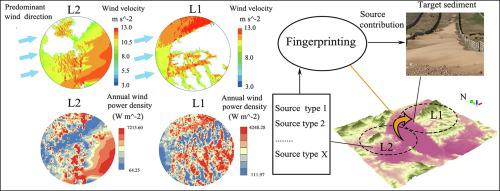Catena ( IF 6.2 ) Pub Date : 2021-04-24 , DOI: 10.1016/j.catena.2021.105372 Yang Zhao , Qizhi Zhou , Guanglei Gao , Guodong Ding , Ying Zhang , Jinxing Zhou

|
A systematic understanding of the transport processes of aeolian sand from source to sedimentary areas is important for both hazard control and fundamental mechanism research. This study proposes a methodological framework consisting of wind data standardisation, computational fluid dynamics (CFD) simulation and fingerprinting technology to clarify aeolian sediment transport processes. The methodological framework was applied to the Cuona Lake section of the Qinghai-Tibetan Railway as a case study. One main finding was that the mountain passes located on the west of the lake act as outlets that converge and accelerate the predominant wind. The Basuoqu river valley and Amdo-Cuona down-faulted valley act as a ventilation tunnel in the sedimentary area. The CFD simulation clearly showed the influence of the complex terrain on the wind flow field. Second, the area southwest of the lake was predicted to be the main sediment source; a large portion of this area has an annual wind power density exceeding 1000 W/m2. Third, the fingerprinting estimation results revealed that the predicted main source area contributed more than 80% to the target sediment, which was in good agreement with the CFD simulation result. A decision-tree is provided to guide interested users in critical choices for different situations and research objectives. This CFD- and fingerprinting- based framework has the potential to contribute significantly to aeolian research and facilitate the development of a more detailed methodology.
中文翻译:

结合计算流体动力学和指纹分析评估风沙沉积过程的新方法框架
对风沙从源头到沉积区的迁移过程的系统理解,对于危害控制和基本机理研究都具有重要意义。这项研究提出了一个由风数据标准化,计算流体动力学(CFD)模拟和指纹识别技术组成的方法框架,以阐明风沙沉积物的运输过程。该方法框架被应用到青藏铁路库纳湖段作为案例研究。一个主要发现是位于湖西的山口充当了汇合并加速主要风向的出口。Basuoqu河谷和Amdo-Cuona断层谷是沉积区的通风隧道。CFD仿真清楚地表明了复杂地形对风流场的影响。其次,预计该湖西南部地区将是主要的泥沙源。该地区的大部分地区的年风力发电密度超过1000 W / m2。第三,指纹图谱估算结果表明,预测的主要源区对目标沉积物的贡献率超过80%,与CFD模拟结果吻合良好。提供决策树,以指导感兴趣的用户针对不同情况和研究目标进行关键选择。这种基于CFD和指纹识别的框架具有极大地促进风沙研究的潜力,并有助于开发更详细的方法。


























 京公网安备 11010802027423号
京公网安备 11010802027423号